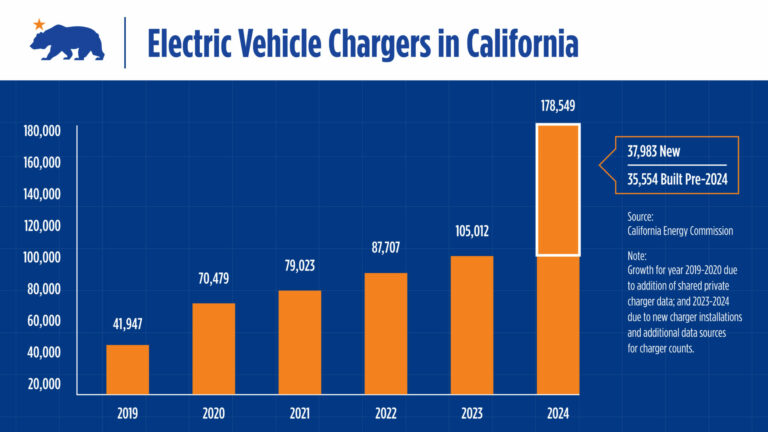California Leads the Way in EV Infrastructure
California has reached a significant milestone in its clean transportation journey, surpassing the number of gasoline nozzles with a 48% increase in public and shared private electric vehicle (EV) chargers. As of 2024, the state has installed over 178,000 EV chargers, more than doubling the number since 2022.
Key Statistics:
- Total EV chargers: 178,549
- Level 2 chargers: over 162,000
- Fast chargers: nearly 17,000
- Level 2 chargers in single-family homes: over 700,000 (estimated by CEC)

Governor Gavin Newsom emphasized California’s commitment to a clean car future, stating, “We now have nearly 50% more chargers than gas nozzles in the state, meaning you have more options than ever to charge your vehicle.” The California Energy Commission (CEC) estimates that there are about 120,000 gas nozzles in the state.
Advancing EV Infrastructure
The state has dedicated billions to support zero-emission vehicle (ZEV) infrastructure. A recent $1.4 billion investment plan aims to expand the most extensive charging and hydrogen network in the country. Projects like the Fast Charge California Project, part of the California Electric Vehicle Infrastructure Project (CALeVIP), will award $55 million to install EV fast-charging stations across the state.
CEC Chair David Hochschild noted, “The California EV driver experience is getting better by the day. The state continues to invest in EV infrastructure, with particular emphasis in hard-to-reach areas, making these vehicles an easy choice for new car buyers.”
Improving Data Collection and Infrastructure Planning
To better understand where chargers are most needed, California is working to improve data collection. The updated charger totals announced recently are a result of the CEC’s efforts to track operational chargers more effectively. Of the 73,537 chargers added to the data set in 2024, nearly 38,000 were new installations, while the remaining were previously installed chargers identified through new data sources.
Statewide Efforts and Collaborations
State agencies are working to accelerate charger deployment by cutting red tape, establishing guidelines, and planning for increased grid demand. The Newsom Administration is also prioritizing clean fuel production, public transit enhancements, and a smarter electric grid to support California’s clean transportation future.
As California continues to lead in ZEV adoption, with 1 in 4 Californians choosing zero-emission models for the last two years, the state remains committed to its clean transportation goals. Thirty percent of new ZEVs sold in the U.S. are purchased in California, according to the California Air Resources Board.



